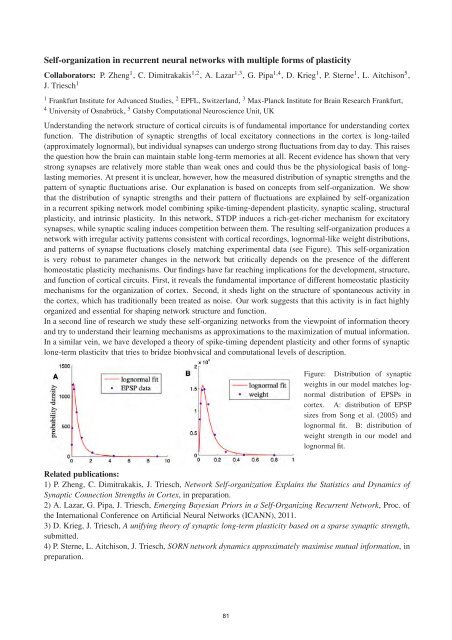FIAS Scientific Report 2011 - Frankfurt Institute for Advanced Studies ...
FIAS Scientific Report 2011 - Frankfurt Institute for Advanced Studies ...
FIAS Scientific Report 2011 - Frankfurt Institute for Advanced Studies ...
Create successful ePaper yourself
Turn your PDF publications into a flip-book with our unique Google optimized e-Paper software.
Self-organization in recurrent neural networks with multiple <strong>for</strong>ms of plasticity<br />
Collaborators: P. Zheng 1 , C. Dimitrakakis 1,2 , A. Lazar 1,3 , G. Pipa 1,4 , D. Krieg 1 , P. Sterne 1 , L. Aitchison 5 ,<br />
J. Triesch 1<br />
1 <strong>Frankfurt</strong> <strong>Institute</strong> <strong>for</strong> <strong>Advanced</strong> <strong>Studies</strong>, 2 EPFL, Switzerland, 3 Max-Planck <strong>Institute</strong> <strong>for</strong> Brain Research <strong>Frankfurt</strong>,<br />
4 University of Osnabrück, 5 Gatsby Computational Neuroscience Unit, UK<br />
Understanding the network structure of cortical circuits is of fundamental importance <strong>for</strong> understanding cortex<br />
function. The distribution of synaptic strengths of local excitatory connections in the cortex is long-tailed<br />
(approximately lognormal), but individual synapses can undergo strong fluctuations from day to day. This raises<br />
the question how the brain can maintain stable long-term memories at all. Recent evidence has shown that very<br />
strong synapses are relatively more stable than weak ones and could thus be the physiological basis of longlasting<br />
memories. At present it is unclear, however, how the measured distribution of synaptic strengths and the<br />
pattern of synaptic fluctuations arise. Our explanation is based on concepts from self-organization. We show<br />
that the distribution of synaptic strengths and their pattern of fluctuations are explained by self-organization<br />
in a recurrent spiking network model combining spike-timing-dependent plasticity, synaptic scaling, structural<br />
plasticity, and intrinsic plasticity. In this network, STDP induces a rich-get-richer mechanism <strong>for</strong> excitatory<br />
synapses, while synaptic scaling induces competition between them. The resulting self-organization produces a<br />
network with irregular activity patterns consistent with cortical recordings, lognormal-like weight distributions,<br />
and patterns of synapse fluctuations closely matching experimental data (see Figure). This self-organization<br />
is very robust to parameter changes in the network but critically depends on the presence of the different<br />
homeostatic plasticity mechanisms. Our findings have far reaching implications <strong>for</strong> the development, structure,<br />
and function of cortical circuits. First, it reveals the fundamental importance of different homeostatic plasticity<br />
mechanisms <strong>for</strong> the organization of cortex. Second, it sheds light on the structure of spontaneous activity in<br />
the cortex, which has traditionally been treated as noise. Our work suggests that this activity is in fact highly<br />
organized and essential <strong>for</strong> shaping network structure and function.<br />
In a second line of research we study these self-organizing networks from the viewpoint of in<strong>for</strong>mation theory<br />
and try to understand their learning mechanisms as approximations to the maximization of mutual in<strong>for</strong>mation.<br />
In a similar vein, we have developed a theory of spike-timing dependent plasticity and other <strong>for</strong>ms of synaptic<br />
long-term plasticity that tries to bridge biophysical and computational levels of description.<br />
Figure: Distribution of synaptic<br />
weights in our model matches lognormal<br />
distribution of EPSPs in<br />
cortex. A: distribution of EPSP<br />
sizes from Song et al. (2005) and<br />
lognormal fit. B: distribution of<br />
weight strength in our model and<br />
lognormal fit.<br />
Related publications:<br />
1) P. Zheng, C. Dimitrakakis, J. Triesch, Network Self-organization Explains the Statistics and Dynamics of<br />
Synaptic Connection Strengths in Cortex, in preparation.<br />
2) A. Lazar, G. Pipa, J. Triesch, Emerging Bayesian Priors in a Self-Organizing Recurrent Network, Proc. of<br />
the International Conference on Artificial Neural Networks (ICANN), <strong>2011</strong>.<br />
3) D. Krieg, J. Triesch, A unifying theory of synaptic long-term plasticity based on a sparse synaptic strength,<br />
submitted.<br />
4) P. Sterne, L. Aitchison, J. Triesch, SORN network dynamics approximately maximise mutual in<strong>for</strong>mation, in<br />
preparation.<br />
81
















